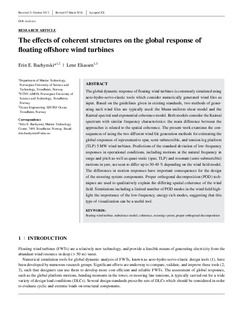| dc.contributor.author | Bachynski, Erin Elizabeth | |
| dc.contributor.author | Eliassen, Lene | |
| dc.date.accessioned | 2019-01-30T08:50:55Z | |
| dc.date.available | 2019-01-30T08:50:55Z | |
| dc.date.created | 2018-10-30T16:44:20Z | |
| dc.date.issued | 2018 | |
| dc.identifier.issn | 1095-4244 | |
| dc.identifier.uri | http://hdl.handle.net/11250/2582995 | |
| dc.description.abstract | The global dynamic response of floating wind turbines is commonly simulated using aero‐hydro‐servo‐elastic tools that consider numerically generated wind files as input. Based on the guidelines given in existing standards, two methods of generating such wind files are typically used: the Mann uniform shear model and the Kaimal spectral and exponential coherence model. Both models consider the Kaimal spectrum with similar frequency characteristics: The main difference between the approaches is related to the spatial coherence. The present work examines the consequences of using the two different wind file generation methods for estimating the global responses of representative spar, semi‐submersible, and tension leg platform (TLP) 5 MW wind turbines. Predictions of the standard deviation of low‐frequency responses in operational conditions, including motions at the natural frequency in surge and pitch as well as quasi‐static (spar, TLP) and resonant (semi‐submersible) motions in yaw, are seen to differ up to 30% to 40% depending on the wind field model. The differences in motion responses have important consequences for the design of the mooring system components. Proper orthogonal decomposition (POD) techniques are used to qualitatively explain the differing spatial coherence of the wind field. Simulations including a limited number of POD modes in the wind field highlight the importance of the low‐frequency, energy‐rich modes, suggesting that this type of visualization can be a useful tool. | nb_NO |
| dc.language.iso | eng | nb_NO |
| dc.publisher | Wiley | nb_NO |
| dc.title | The effects of coherent structures on the global response of floating offshore wind turbines | nb_NO |
| dc.title.alternative | The effects of coherent structures on the global response of floating offshore wind turbines | nb_NO |
| dc.type | Journal article | nb_NO |
| dc.type | Peer reviewed | nb_NO |
| dc.description.version | acceptedVersion | nb_NO |
| dc.source.pagenumber | 219-238 | nb_NO |
| dc.source.volume | 22 | nb_NO |
| dc.source.journal | Wind Energy | nb_NO |
| dc.source.issue | 2 | nb_NO |
| dc.identifier.doi | 10.1002/we.2280 | |
| dc.identifier.cristin | 1625105 | |
| dc.description.localcode | Locked until 30.10.2019 due to copyright restrictions. This is the peer reviewed version of an article, which has been published in final form at [https://doi.org/10.1002/we.2280]. This article may be used for non-commercial purposes in accordance with Wiley Terms and Conditions for Self-Archiving. | nb_NO |
| cristin.unitcode | 194,64,20,0 | |
| cristin.unitname | Institutt for marin teknikk | |
| cristin.ispublished | true | |
| cristin.fulltext | postprint | |
| cristin.qualitycode | 2 | |
